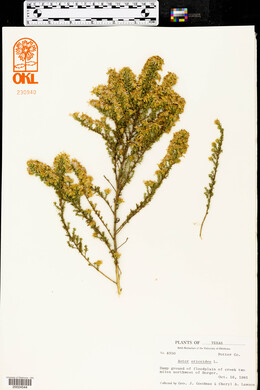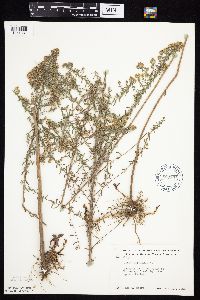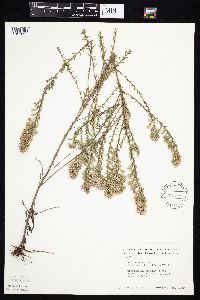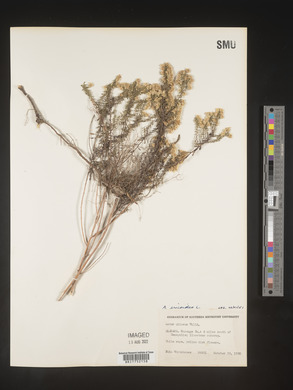Symphyotrichum ericoides
|
|
|
|
Family: Asteraceae
White Heath American-Aster, more...white heath aster
[Aster ericoides L., moreAster ericoides ericoides , Aster ericoides f. caeruleus S. F. Blake, Aster ericoides subsp. ericoides var ericoides , Aster ericoides subsp. ericoides var. ericoides , Aster ericoides var. randi , Aster multiflorus var. caeruleus , Lasallea ericoides (L.) Semple & L. Brouillet, Symphyotrichum ericoides subsp. pansum , Virgulus ericoides (L.) Reveal & Keener] |
Perennials, 20-80(-100) cm, colonial or cespitose, eglandular; branched rhizomatous, or with ± cormoid, branched, woody caudices. Stems 1-3+, ascending to erect (grayish brown to brown), sparsely to densely hispido-strigose, sometimes glabrescent proximally. Leaves usually all except rameal withered by flowering, (light grayish green) firm apices ± white-spine-tipped (often with clusters of smaller leaves in axils); basal sessile, blades (3-nerved) oblanceolate to oblong or spatulate, 10-50 × 10-25 mm, bases attenuate, margins usually entire, rarely remotely serrate, scabrous, apices rounded to obtuse, faces usually sparsely hairy, often glabrous; proximal cauline sessile, blades (1- or 3-nerved) linear to lanceolate or oblong, 10-40(-60) × 1.5-4(-7) mm, reduced distally, bases cuneate, coarsely ciliate, margins entire, coarsely ciliate, apices acute or obtuse, faces moderately to densely strigose or hirsute; distal sessile, blades oblong-ovate, 10-40 × 1.5-3.5 mm, abruptly reduced distally, bases cuneate, margins entire, apices acute, faces moderately to densely strigose. Heads (1-200+) in paniculiform arrays, branches fastigiate or arrays often pyramidal, racemiform, secund, crowded. Peduncles 0.5-1(-2) cm or subsessile, densely hairy, bracts dense, linear to narrowly lanceolate, usually reflexed, sometime appressed to ascending, 1.5-5(-6) mm, densely hairy, grading into phyllaries. Involucres cylindric to campanulate, 2.5-4.5(-5) mm. Phyllaries in 3-4 series, oblanceolate to ± spatulate, unequal, firm, bases (whitish to tan) ± indurate in proximal 1 / 2 - 2 / 3 , margins hyaline, scabrous proximally, green zones diamond-shaped, in distal 1 / 2 , apices spine-tipped, (outer) spreading to reflexed or squarrose, faces (outer) sparsely to densely hispid, scabroso-hirsute adaxially, (inner) glabrous. Ray florets (8-)10-18(-20); corollas usually white, rarely pink or bluish, laminae 6-12(-20) × 0.7-1.2 mm. Disc florets 6-12(-20); corollas yellow becoming brown, 2.5-4 mm, throats narrowly funnelform, lobes triangular, 0.5-0.6 mm, glabrous. Cypselae deep purple turning brown, obovoid to oblong-obovoid, ± falcate, not compressed, 1.2-2 × 0.4-0.6 mm, 7-9-nerved (faint), faces sericeous or densely strigillose; pappi whitish, 3-4 mm. Symphyotrichum ericoides resembles S. pilosum var. pilosum, which has larger heads, longer rays, and phyllaries that are not spine-tipped, though the revolute margins can make them appear so. Two subspecies and four weakly separated varieties of S. ericoides were recognized by A. G. Jones (1978). Tetraploids of var. ericoides on the eastern prairies can be difficult to distinguish from S. falcatum. A number of aster cultivars are sold under the name 'Aster ericoides.' These are all derived from European garden plants and are either cultivars of S. dumosum, S. lateriflorum, S. pilosum, or S. racemosum, or hybrids involving one of those species and another taxon. The misapplication of the epithet ericoides dates back to the nineteenth century and has persisted in the horticultural literature.
Plants 3-10 dm, hairy (the hairs appressed or spreading), colonial by long creeping rhizomes, the stems arising singly; lvs numerous, linear, sessile, to 6 cm נ7 mm, the lower and often also the middle ones soon deciduous, those of the branches reduced and divaricate; heads numerous, small, commonly somewhat secund on the divergent or recurved branches; invol 3-5 mm, its bracts ±strongly imbricate, the outer obtuse or acutish, spinulose-mucronate, and ±squarrose, some of or all the bracts coarsely ciliolate-margined, and usually also short-hairy on the back; rays 8-20, white (blue or pink), 3-6 mm; disk-fls 4-15(-20); achenes sericeous-strigose; 2n=10, 20, 30. Dry, open places; s. Me. to se. Man., s. to Del., n. Va., Tenn., s. Ill., Ark., Tex., n. Mex., and se. Ariz. The closely allied, more northwestern sp. A. pansus (S. F. Blake) Cronquist, with the stems clustered on a caudex or very short rhizome, may be sought in nw. Minn. Gleason, Henry A. & Cronquist, Arthur J. 1991. Manual of vascular plants of northeastern United States and adjacent Canada. lxxv + 910 pp. ©The New York Botanical Garden. All rights reserved. Used by permission. |
|
|
|




























































































